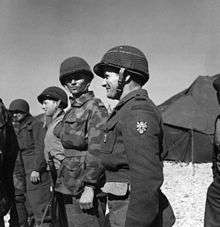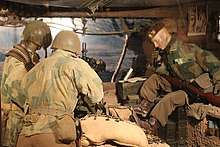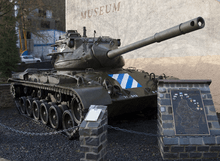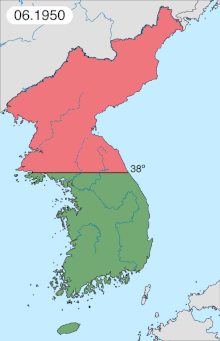Belgian United Nations Command
The Volunteer Corps for Korea (French: Corps de Volontaires pour la Corée), later known as Belgian United Nations Command (BUNC), was a Belgian–Luxembourg military force sent to assist South Korea during the Korean War. A battalion-sized unit, it arrived in Korea in 1951 and remained after the cease-fire until 1955. Over the course of its existence, 3,171 Belgians and 78 Luxembourgers served in the unit.[8]
| Belgian United Nations Command (BUNC) | |
|---|---|
 Luxembourgish soldier, part of B.U.N.C. in Korea, 1953 | |
| Active | 1950–1955 |
| Disbanded | 1955 |
| Country | |
| Allegiance | |
| Branch | Army |
| Type | Infantry Battalion |
| Size | Total: |
| Part of | 29th Commonwealth Brigade 1st US Cavalry Division 3rd US Infantry Division |
| Engagements | |
| Decorations | 2 ROK Presidential Unit Citations US Presidential Unit Citation Belgian Order of Leopold[3] |
| Battle honours | Imjin, Haktang-ni and Chatkol |
| Commanders | |
| Notable commanders | Albert Crahay[4][5] Lt. Col. G. Vivario[6] Lt. Col. R. Gathy[7] |
Background
Belgium, a country in northern Europe, became a signatory member of the United Nations (UN) in 1945 in the aftermath of World War II but had few pre-existing ties with East Asia. The Belgian Army operated a system of national service and already had sizeable commitments as part of the army of occupation in West Germany.
At the time the Korean War broke out in June 1950 the country was in the midst of a political crisis known as the Royal Question. This related to whether King Leopold III should be able to return to the throne after his actions in German-occupied Belgium in World War II but created a wider confrontation between left-leaning communist, socialist and trade-union circles which opposed the King's return and conservatives who supported it. The crisis brought the centre-right Christian Social Party to power although a compromise solution was found in August 1950 under which the King abdicated in favour of his son.
Prime Minister Joseph Pholien was opposed to the rise of communism abroad and wished to gain support from the United States. Both Belgian and Luxembourg governments decided to raise a volunteer-only formation to serve under UN command in the defence of South Korea.
Training
Over 2,000 Belgians volunteered for service in B.U.N.C. Of these, initially only 700 were selected for training at Leopoldsburg. After training, volunteers received their characteristic brown berets. Soldiers from Luxembourg who were trained alongside the Belgians were organised into 1st Platoon, A Company of B.U.N.C.[9]
The Belgian-Luxembourg Corps sailed from Antwerp to Pusan and arrived on 31 January 1951.[10] On arrival in Korea, some South Korean troops were made part of the Belgian contingent in order to bring the regiment up to correct battalion strength along the lines of the US "KATUSA" or Commonwealth "KATCOM" programme.
At the front

In April 1951, the Belgians fought in one of the key battles of the Korean War – the Battle of the Imjin River. The First Battalion was relieved by a new battalion fresh from Belgium in August 1951[11] which stayed until 1955.
At the Battle of the Imjin River in 1951, the Belgian battalion held a key pass alongside the British Gloucestershire Regiment. For actions at the Imjin, the Belgians received a US Presidential Citation. During the battle, Albert Crahay, commander of the unit, was wounded by a Chinese phosphorus shell and was evacuated to a hospital in Japan.
B.U.N.C. continued to see action and went on to earn further battle honours at Haktang-Ni – one of the series of battles at Broken Arrow – in October 1951 when the Belgians took up position on an isolated hillside and suffered relentless Chinese attacks which they successfully repelled, killing over a hundred Chinese and losing only a handful of men themselves.
The last main action fought by the Belgian contingent was at the Battle of Chatkol in April 1953. Belgian forces held a defensive arc position in the Iron Triangle for over 55 nights of Chinese assaults.
After the cease-fire, it was seen as unnecessary to keep BUNC up to the strength it had during the war and it was reduced to some 200 men on 30 December 1954, but, like other UN contingents, it was viewed as necessary to maintain a presence in Korea during the uncertain peace following the negotiations at Panmunjom and the last members of the unit finally left Korea on 15 June 1955.
Commanders
Belgian Commanders[12][13]
| Dates in Command | Name of Commander (all held rank of Lieutenant-Colonel in Korea) | Notable event during command | Future career |
|---|---|---|---|
| September 28, 1950 – November 21, 1951 | Albert Crahay | First Commander of the Contingent; Battle of the Imjin River. Wounded by Phosphorus Grenade | Retired with rank of Lieutenant General. He also commanded the Belgian army of occupation in Germany. |
| November 21, 1951 – February 23, 1952 | Norbert Cools | Replaced for health reasons. | |
| February 23, 1952 – February 13, 1953 | Georges Vivario | Battle of Haktang-ni | Became Commander of the Joint General Staff and retired with the rank of Lieutenant General. |
| February 12, 1953 – July 12, 1953 | Robert Gathy | Battle of Chatkol | |
| July 12, 1953 – December 19, 1953 | Bodart | Armistice in the Korean War | |
| December 19, 1953 – May 27, 1954 | Brichant (Major) (temp.) | ||
| February 27, 1954 – August 14, 1955 | Pierlot | Belgian United Nations Command disbanded | |
Luxembourgish Commanders
| Dates in Command | Name of Commander (all held rank of Lieutenant in Korea) | Notable event during command | Future career |
|---|---|---|---|
| October 1, 1951 – September 30, 1951 | Joseph "Jos" Wagener | 1st Luxembourgish Detachment, Operations around the Han River, Battle of the Imjin River | Later Lt. Col. |
| February 4, 1952 – February 3, 1953 | Rodolphe "Rudy" Lutty | 2nd Luxembourgish Detachment, Battle of King Post | |
"Belgians Can Do Too!"
BELGIANS CAN DO TOO! was a slogan written across the windshield of Padre of the Unit's (Padre Vander Goten) Jeep during the battles around the "Iron Triangle." Seeing the exhaustion of the troops, the Padre copied the motto of the US 15th Infantry Regiment ("Can Do") alongside whom the Belgians were serving at the time to try to raise morale. The phrase was made famous in Belgium and is thought to summarise the spirit and courage of the Belgian contingent.[14][15]
Casualties
101 Belgian soldiers, 2 Luxembourgish soldiers and 9 South Korean soldiers attached to the Belgian contingent were killed during the war. 478 Belgians and 17 Luxembourgers were wounded in action and 5 Belgians are still posted as missing. 2 died in North Korean POW Camps.[16]
Battle honours

B.U.N.C. was awarded two South Korean Presidential Unit Citations and one American Unit Citation.
The text of the US Presidential Unit Citation for actions at the Imjin River:
The Belgian battalion with the Luxembourg detachment of the UN Forces in Korea is mentioned for exceptional execution of its missions and for its remarkable heroism in its actions against the enemy on the Imjin, near Hantangang, Korea during the period from 20 till 26 April 1951. The Belgian battalion with the Luxembourg detachment, one of the smallest units of the UNO in Korea, has inflicted thirty-fold losses on the enemy compared to its own, due to its aggressive and courageous actions against the Communist Chinese. During this period considerable enemy forces, supported by fire by machine guns, mortars and artillery, repeatedly and heavily attacked the positions held by the battalion but, Belgians and Luxembourgers have continuously and bravely repulsed these fanatic attacks by inflicting heavy losses to the enemy forces...The extraordinary courage shown by the members of this units during this period has bestowed extraordinary honor on their country and on themselves
By order of
The Belgian-Luxembourg Corps served at three key battles of the Korean War – the Battle of the Imjin River and Battle of Haktang-ni 1951, and the Battle of Chatkol 1953.
Commemoration

The 3rd Parachute Battalion maintains the traditions (including the flag and badge) of BUNC and is based in Tielen.
Museums
- The National Museum of Military History in Diekirch, Luxembourg has a permanent gallery and memorial on the participation of B.U.N.C in Korea.
- There is a small museum attached to the Barracks of the 3rd Parachute Battalion, Belgian Army, in Tielen, Belgium which focuses on the Belgian participation in the Korean War.
- In 2011, The Royal Museum of the Armed Forces and of Military History in Brussels, Belgium put on a temporary exhibition entitled Belgians Can Do Too! about B.U.N.C. in Korea.
Monuments
- Twin Belgian battalion monuments exist in Brussels – on Avenue Jules César- and in South Korea -Dongducheon-si in Gyeonggi-do province.
- There is a small monument outside the Freedom Protection Museum, also in Dongducheon-si, South Korea.
- There is also a small monument outside SHAPE Headquarters in Mons, Belgium.
Notable personnel
- Etienne Gailly, Bronze medal winner at the 1948 London Olympic Games served as Captain in BUNC alongside his brother Pierre.[18]
- Pierre Francisse, 1948 London Olympic Games, track and 1960 Rome Olympic Games, Fencing (épée), was a Lieutenant in Korea. He was too severely wounded to continue his track event, and took up fencing for the Belgian Olympic team. Retired as a Colonel of the First Regiment Guides.
- Albert Guérisse was a notable member of the Belgian resistance during the Second World War. He created the Pat Line to help Allied Airmen escape capture in Nazi-Occupied Europe under the pseudonym Pat O'Leary. After serving in Korea he became the commander of the Belgian Medical Component with the rank of Major-General.[19]
- Henri Moreau de Melen, Minister of Defence for the Christian Social Party (PSC-CVP) government who resigned his ministerial post and volunteered for service in Korea in 1950 with the rank of Major.
- Guy de Greef, a captain in B.U.N.C. and who served at the Battle of Chatkol in 1953 was the son of the Belgian Minister of Defense Eugène De Greef who held the post 1950–1954 after Moreau de Melen's resignation.[20]
- Benoît Verhaegen, later a notable Africanist
See also
References
- "Belgian Volunteer Corps Korea". belgian-volunteercorps-korea.be. Retrieved 4 November 2012.
- "Belgian Volunteer Corps Korea". belgian-volunteercorps-korea.be. Retrieved 4 November 2012.
- "BUNC". hendrik.atspace.com. Archived from the original on 12 August 2013. Retrieved 4 November 2012.
- "Citations, awards and Medal". militarytimes.com. Retrieved 4 November 2012.
- "National Archives". www.koreanwar-educator.org. Retrieved 4 November 2012.
- "National Archives". www.koreanwar-educator.org. Retrieved 4 November 2012.
- "National Archives". www.koreanwar-educator.org. Retrieved 4 November 2012.
- "HOME Webmaster Jan Dillen Korea veteraan".
- "Belgian Volunteer Corps Korea". belgian-volunteercorps-korea.be. Retrieved 4 November 2012.
- "The Belgian Forces in the Korean War". Archived from the original on 2013-08-12.
- "The Belgian Forces in the Korean War". Archived from the original on 2013-08-12.
- http://users.telenet.be/belgischbataljonkorea/english/history.htm%5B%5D
- "Korean War Educator: Topics - National Archives Records - RIP 103".
- De Wit, Frans (2003). Belgians Can Do Too!. De Krijger. ISBN 9058680665. Retrieved 4 November 2012.
- Belgians Can Do Too! The Belgian-Luxembourg Battalion in Korea, Royal Museum of the Army and of Military History, Brussels ISBN 2-87051-050-0, p.53
- "HOME Webmaster Jan Dillen Korea veteraan".
- "The Belgian Forces in the Korean War". Archived from the original on 2013-08-12.
- "Etienne Gailly". belgraveharriers.com. Archived from the original on 7 February 2012. Retrieved 4 November 2012.
- "Albert Guerisse: Belgian war hero". nytimes.com. Retrieved 4 November 2012.
- Belgians Can Do Too! The Belgian-Luxembourg Battalion in Korea, Royal Museum of the Army and of Military History, Brussels ISBN 2-87051-050-0, p.169-173
External links
| Wikimedia Commons has media related to Belgium in the Korean War. |
- (in English, Dutch, and French) "Belgian-Volunteercorps-Korea.be". Retrieved 4 November 2011.
- "Belgiansandthekoreanwar.co.uk". Archived from the original on 16 May 2013. Retrieved 1 November 2012.
- "BUNC". hendrik.atspace.com. Archived from the original on 12 August 2013. Retrieved 4 November 2012.
- "'Good things come in small packages'". Archived from the original on 7 March 2016. Retrieved 4 November 2012.
- "The Brown Berets". Esprit de Corps. Archived from the original on 6 March 2016. Retrieved 4 November 2012.
- The Belgians and Luxembourgers who fought in Korea Facebook Group
- "anciens-combattants.lu" (in French). Archived from the original on 19 February 2013. Retrieved 4 November 2012.
- "Museum" (in Dutch). Archived from the original on 10 November 2011. Retrieved 4 November 2011.
- Le Roy, David. "Het Belgische Korea-bataljon" (in Dutch). ethesis.net. Retrieved 4 November 2012.
